2013 年北京科技大学翻译硕士英语考研真题
北 京 科 技 大 学
2013 年硕士学位研究生入学考试试题
试题编号: 211
试题名称:
翻译硕士英语
适用专业:
翻译(专业英语)
说明: 所有答案必须写在答题纸上,做在试题或草稿纸上无效。
==============================================================================
===============================
I. Vocabulary and Structure (30 points, 1 point each, 60 minutes)
Directions:Beneath each sentence there are four words or phrasesmarked A, B, C,
and D. Choose the answer that best completes the sentence. Write your answers on
your answer sheet.
1. Ruth wanted to be transferred to another department, but her application was
_____ because her own department is understaffed.
A. turned down
B. turned over
C. turned away
D. turned off
2. Helen’s been neglecting her homework lately. I’ll _____ with her parents about
it.
A. have words
B. have a word
C. have the word
D. have the last word
3. The reality of governance is rarely ______; institutions do not operate according
to mechanical laws, but they evolve organically.
A. noble
B. static
C. inconsistent
D. documented
4. A position that requires public speaking would be very difficult for one as _____
as he.
A. amiable
B. vivacious
C. reticent
D. decent
5. The commission asked that the administration’s 90-day ban on federal funds for
human cloning _____ indefinitely.
A. to be extended
B. to extend
extended
C. be extended
D.
being
6. There is talk of the government _______ a new tax relief scheme for families
with more than three children.
�
A. bringing in
B. bringing off
C. bringing about
D. bringing on
7. The nurses asked the local union to ______ their strike by signing a letter of
support.
A. comply
B. undermine
C. endorse
D. isolate
8. I could not but _____ very much delighted with several modern epitaphs, which
are written with great elegance of expression.
A. being
C. to be
B. be
D. was
9. ______ more societies are geared to retirement at around 65, companies have a
looming problem of knowledge management.
A. Given that
B. Provided
C. Unless
D. While
10. The organization gives help and support to people in need, as well as _____ money
for local charities.
A. raises
B. raising
C. raise
D. to raise
11. The development of containers, possibly made from bark or the skins of animals,
although it is a matter of ______, allowed the extensive sharing of forage food
in prehistoric human societies.
A. conjecture
D. conspiracy
C. record
B. fact
12. Most people choose a lawyer on the basis of such _____ considerations as his
cost, his field of expertise, and the fees he charges.
A. humanistic
B. irrelevant
C. personal
D. pragmatic
13. It cannot be denied that the existing resources on earth will be depleted, but
scientists are hesitant to ______ the inevitability of that day, convinced that
new energies can be found in the near future.
A. recede
C. concede
D. precede
B. exceed
14. There has been nothing good on television for weeks. Good programs are _______.
A. more or less
B. far and between
C. on and off
D. here and there
15. Fred is a(n) ______ complainer— as soon as one problem is solved, he will come
up with another.
A. affluent
B. prudent
C. moderate
D. chronic
16. Rita turned her ______ of being lost in the desert into good fortune by selling
the story to a movie studio.
A. ordeal
B. pessimism
C. retort
D. patron
17. Psychologists maintain that the nature of human beings entails a strong need
to _____ their free time; idleness can be as stressful as activity.
�
A. endanger
B. preserve
C. consume
D. organize
18. At age 10, my cousin still has a _____ belief in Santa Claus; she becomes upset
at any suggestion that he doesn’t exist.
A. sedentary
B. inquisitive
C. tenacious
D. superfluous
19. They ______ each other, making a perfect couple. He is rich but doesn’t care
about money; she is poor but cares about it a lot.
A. complement
B. fabricate
C. implement
D. validate
20. People anticipated that vertical flight transports would carry millions of
passengers as _______ today.
A. the airliners do
B. do the airliners
airliners
C. the airliners did
D. did the
21. Rumors, embroidered with detail, live on for years, neither denied nor confirmed,
until they become accepted as fact even among people not known for their _____.
A. insight
B. introspection
C. obstinacy
D. credulity
22. Imposing steep fines on employers for on-the-job injuries to workers could be
an effective ______ creating a safer workplace, especially in the case of
employers with poor safety records.
A. alternative
C. incentive
D. deterrent
B. addition
23. Her ______ should not be confused with miserliness, as long as I have known her,
she has always been willing to assist those who are in need.
A. frugality
C. intolerance
B. diffidence
D. apprehension
24. Observable as a tendency of our culture is a _______ of belief in psychoanalysis:
we no longer feel that it can solve out emotional problems.
A. defence
B. confrontation
C. divergence
D. withdrawal
25. The prospects of discovering new aspects of the life of a painter as thoroughly
studied as Vermeer are not, on the surface, _______.
A. unpromising
C. daunting
B. encouraging
D. challenging
26. The history of film reflects the ________ inherent in the medium itself: film
contains still photographs to represent continuous motion and, while seeming
to present life itself, can also offer impossible and dreamlike unrealities.
A. biases
B. constraints
C. liabilities
D. paradoxes
27. The notion that cultural and biological influences equally determine
cross-cultural diversity is _____ by the fact that, in countless aspects of human
existence, it is cultural programming that overwhelmingly accounts for
�
cross-population variance.
A. confirmed B. illustrated
C. discredited
D. disapproved
28. Dominant interests often benefit most from ________ of governmental interference
in business, since they are able to take care of themselves if left alone.
A. centralization
C. intensification
B. authorization
D.
elimination
29. As the world has moved into a scientific age, the origin of herbal medicine in
many countries remains _____ in mystery and often sounds fantastic to those
trained in modern science.
B. hidden
A. shrouded
D. hindered
C. covered
30. We can scarcely afford to neglect airport security in light of the recent
terrorist actions, but as a reliable critic has pointed out, the cost of actually
implementing these measures remains a _______ expense.
A. feasible
B. prohibitive
D. negligible
C. suitable
II. Reading Comprehension (40 points, 2 points each, 60 minutes)
Section I
Directions: In this section there are two reading passages followed by multiple
choicequestions.Readthepassagesandthenwriteyouransweronyouranswersheet.
Passage One
When Ford’s River Rouge Plant was completed in 1928 it boasted everything it
needed to turn raw materials into finished cars: 100,000 workers, 16m square feet
of factory floor, 100 miles of railway track and its own docks and furnaces. Today
it is still Ford’s largest plant, but only a shadow of its former glory. Most of
the parts are made by sub-contractors and merely fitted together by the plant’s
6,000 workers. The local steel mill is run by a Russian company, Severstal.
Outsourcing has transformed global business. Over the past few decades companies
have contracted out everything from mopping the floors to spotting the flaws in their
internet security. TPI, a company that specializes in the sector, estimates that
$100 billion-worth of new contracts are signed every year. Oxford Economics reckons
that in Britain, one of the world’s most mature economies, 10% of workers toil away
in “outsourced” jobs and companies spend $ 200 billion a year on outsourcing. Even
war is being outsourced: America employs more contract workers in Afghanistan than
regular troops.
The latest TPI quarterly index of outsourcing (which measures commercial
contracts of $25m or more) suggests that the total value of such contracts for the
second quarter of 2011 fell by 18% compared with the second quarter of 2010. Dismal
figures in the Americas (i.e. mostly the United States) dragged down the average:
�
the value of contracts there was 50% lower in the second quarter of 2011 than in
the first half of 2010. This is partly explained by America’s gloomy economy, but
even more by the maturity of the market: TPI suspects that much of what can sensibly
be outsourced already has been.
Miles Robinson of Mayer Brown, a law firm, notes that there has also been an
uptick in legal disputes over outsourcing. In one case EDS, an IT company, had to
pay BSkyB, a media company, £318m ($469m) in damages. The two firms spent an estimated
£70m on legal fees and were tied up in court for five months. Such nightmares are
worse in India, where the courts move with Dickensian speed. And since many disputes
stay out of court, the well of discontent with outsourcing is surely deeper than
the legal record shows.
by
years
ago
Boeing,
Eight
America’s
outsourcing.
Some of the worst business disasters of recent years have been caused or
aggravated
biggest
aeroplane-maker, decided to follow the example of car firms and hire contractors
to do most of the grunt work on its new 787 Dreamliner. The result was a nightmare.
Some of the parts did not fit together. Some of the dozens of sub-contractors failed
to deliver their components on time, despite having subcontracted their work to
sub-sub-contractors. Boeing had to take over some of the subcontractors to prevent
them from collapsing. If the Dreamliner starts rolling off the production line
towards the end of this year, as Boeing promises, it will be billions over budget
and three years behind schedule.
Outsourcing can go wrong in a colorful variety of ways. Sometimes companies
squeeze their contractors so hard that they are forced to cut corners. (This is a
big problem in the car industry, where a handful of global firms can bully the 80,000
parts-makers.) Sometimes vendors overpromise in order to win a contract and then
fail to deliver. Sometimes both parties write sloppy contracts. And some companies
undermine their overall strategies with injudicious outsourcing. Service companies,
for example, contract out customer complaints to foreign call centres and then wonder
why their customers hate them.
When outsourcing goes wrong, it is the devil to put right. When companies
outsource a job, they typically eliminate the department that used to do it. They
become entwined with their contractors, handing over sensitive material and inviting
contractors to work alongside their own staff. Extricating themselves from this
tangle can be tough. It is much easier to close a department than to rebuild it.
Sacking a contractor can mean that factories grind to a halt, bills languish unpaid
and chaos mounts.
None of this means that companies are going to re-embrace the River Rouge model
any time soon. Some companies, such as Boeing, are bringing more work back in-house,
in the jargon. But the business logic behind outsourcing remains compelling, so long
as it is done right. Many tasks are peripheral to a firm’s core business and can
be done better and more cheaply by specialists. Cleaning is an obvious example; many
back-office jobs also fit the bill. Outsourcing firms offer labour arbitrage, using
cheap Indians to enter data rather than expensive Swedes. They can offer economies
of scale, too. TPI points out that, for all the problems in America, outsourcing
�
is continuing to grow in emerging markets and, more surprisingly, in Europe, where
Germany and France are late converts to the idea.
Companies are rethinking outsourcing, rather than jettisoning it. They are
dumping huge long term deals in favour of smaller, less rigid ones. The annualized
value of “mega-relationship” worth $100m or more a year fell by 62% this year
compared with last. Companies are forming relationships with several outsourcers,
rather than putting all their eggs in few baskets. They are signing shorter contracts,
too. But still, they need to think harder about what their core business is, and
what is peripheral. And above all, newspaper editors need to say no to the temptation
to outsource business columns to cheaper, hungrier writers.
1. The Ford’s River Rouge Plant case is introduced in the first paragraph to _____.
A. indicate the prevalence of outsourcing
B. lament over the past glory of the plant
C. explain Boeing’s adoption of a similar model
D. expose the weakness of its business model
2. Which of the following statements about outsourcing is correct?
A. Outsourcing in all markets has encountered difficulties.
B. Outsourcing, if well operated, can help reduce the costs.
C. Recession is the major cause for less outsourcing in America.
D. The outsourcing boom will go on indefinitely in spite of problems.
3. Currently companies in America have the following concerns EXCEPT_____.
A. low quality of subcontracted products and services
B. the saturated outsourcing market
C. drastic increase of disputes over outsourcing
D. the necessity of reforming outsourcing model
4. Which of the following solutions is NOT suggested in the passage?
A. Develop several outsourcers to reduce potential risks.
B. Sign short-term and flexible contracts with outsourcers.
C. Rebuild the department to do the job once outsourced.
D. Identify businesses appropriate for outsourcing.
5. The underlined word “peripheral” in paragraph 8 is closest in meaning to _____.
A. indispensable
B. temporary
C. essential
D. secondary
Passage Two
Of all the methods of communication invented by humanity over the centuries,
none has disseminated so much information so widely at such high speeds as the
internet. It is both a unifying force and a globalizing one. But, its very ubiquity
makes it a localizing one too, because it is clearly not the same everywhere, either
�
in what it provides or how it is operated and regulated.
The smartphone has liberated its users from the PC on his desk, granting him
access on the go not just to remote computers and long-lost friends on the other
side of the world but also to the places around him. If he lives in a city, as most
users do, then his fellow city-dwellers and the buildings, cars and streets around
them are throwing off almost unimaginable quantities of valuable data from which
he will benefit. And although communications across continents have become cheap
and easy, physical proximity to others remains important in creating new ideas and
products—especially (and perhaps ironically) for companies offering online
services. You cannot (yet) have a coffee together online.
This simultaneously more localized and more globalized world will be more
complicated than the world of old. Different rules will continue to apply to
different countries’ bits of cyberspace. Gartner’s Mr. Prentice thinks that three
basic forces will shape the mobile internet, the transport of data across it and
the content available on it: politician’s demand for control; (most) people’s
desire for freedom; and companies’ pursuit of profit. It is possible to imagine
scenarios in which one of these forces comes out on top. But it is more likely, says
Mr. Prentice, that different combinations of the three forces will prevail in
different places.
What seems certain is that life online will become more local without becoming
any less global. With a smartphone in your hand you can find out more, if you want
to, about what is going on immediately around you. The next bus goes in five minutes.
The coffee shop across the street, where you haven’t been for a few weeks, is
offering you a free cappuccino. Those cushions you looked at online are available
in the department store around the corner. The smartphone could even help revive
the high street if people knew that they could take home today what Amazon could
not deliver until tomorrow.
None of this will reduce the scope or the appetite for catching up with friends,
news and stories from far away. “The truth is that three things will go on at once,”
says Danny Miller, an anthropologist at UCL. There will continue to be
“unprecedented opportunities for homogenization and globalization”, but there are
also “possibilities for great localization”—including services such as
Foursquare. Lastly, there will be a new localism, thanks to an internet full of local
differences that are not confined to particular places. For example, Trinidadians
use Facebook in a distinctive way to reflect local concepts of scandal and gossip.
But because more than half of Trinidadian families have at least one member living
abroad, this form of use is not tied to Trinidad; it could just as easily be adopted
by Trinidadians living in London or Toronto.
A further prediction is that, as people rely more on connected devices to explore
the physical world, digital information will have a growing influence on how they
see the physical realm and on how they move through it. Mr. Gramham and Mr. Zook,
with Andrew Boulton, also of the University of Kentucky, begin a forthcoming paper
by imagining a young woman’s progress through Dublin on a Saturday night—a kind
of digital “ Ulysses”. She checks texts and tweets from her boyfriend (where is
�
he?), passes a bar (a favorite band once played here) and looks up a review of a
restaurant (seems good). But the city she sees has been digitally constructed for
her. Her boyfriend sends her a text to arrange a meeting place. She knows about the
band because her past online searches have prompted her smartphone to provide the
details. And the restaurant review is nothing more than the sum of other people’s
opinions, delivered electronically.
And this is harmless, even helpful, but there is a darker side to it. Eli Pariser,
an American journalist, has written of a “filter bubble” in which people are
presented only with ideas and opinions that their past online behavior suggests they
are likely to agree with. As they make their digital way through the physical realm,
something similar may happen. Being steered away from areas of high crime late at
night is no bad thing. But not being pointed towards a museum or a club because you
haven’t been anywhere like it before may be a missed opportunity. Standing in front
of a monument and being given a version of history that reinforces your prejudice
closes rather than opens the mind.
Yet on the whole it is surely a good thing for the digital and the physical worlds
to become increasingly interwoven. They are complements, not substitutes for each
other. The digital overlay will, in effect, allow people to see not only through
walls (what’s in that shop?) and around corners (is there a taxi nearby?) but even
through time (what happened here in 1945?). Each realm on its own is fascinating;
together they are irresistible.
6. The passage is mainly about _______.
A. the impact of smartphones upon life online
B. the globalization brought about by the internet
C. the interaction between the digital and physical worlds
D. the development of localism in the era of the globalization
7. According to the passage, which of the following statements is correct?
A. The digital world may shape people’s perception of the physical world.
B. Indulgence in the digital world may cause delusion about the reality.
C. Connected devices have turned people’s life from local to global.
D. Smartphones reduce people’s interest in getting information from far away.
8. The case of a woman’s trip in Dublin in paragraph 6 is presented to _______.
A.
B.
C.
D.
illustrate the function of smartphones in cities
predict the influence of digital information upon physical life
explain the new findings of some scholars
mimic the life delineated in the novel Ulysses
9. The following factors EXCEPT ______ contribute to the localism in life online.
A. easy exploration of the local environment
B. increasingly distinctive local services
C. localized regulations regarding the internet
�
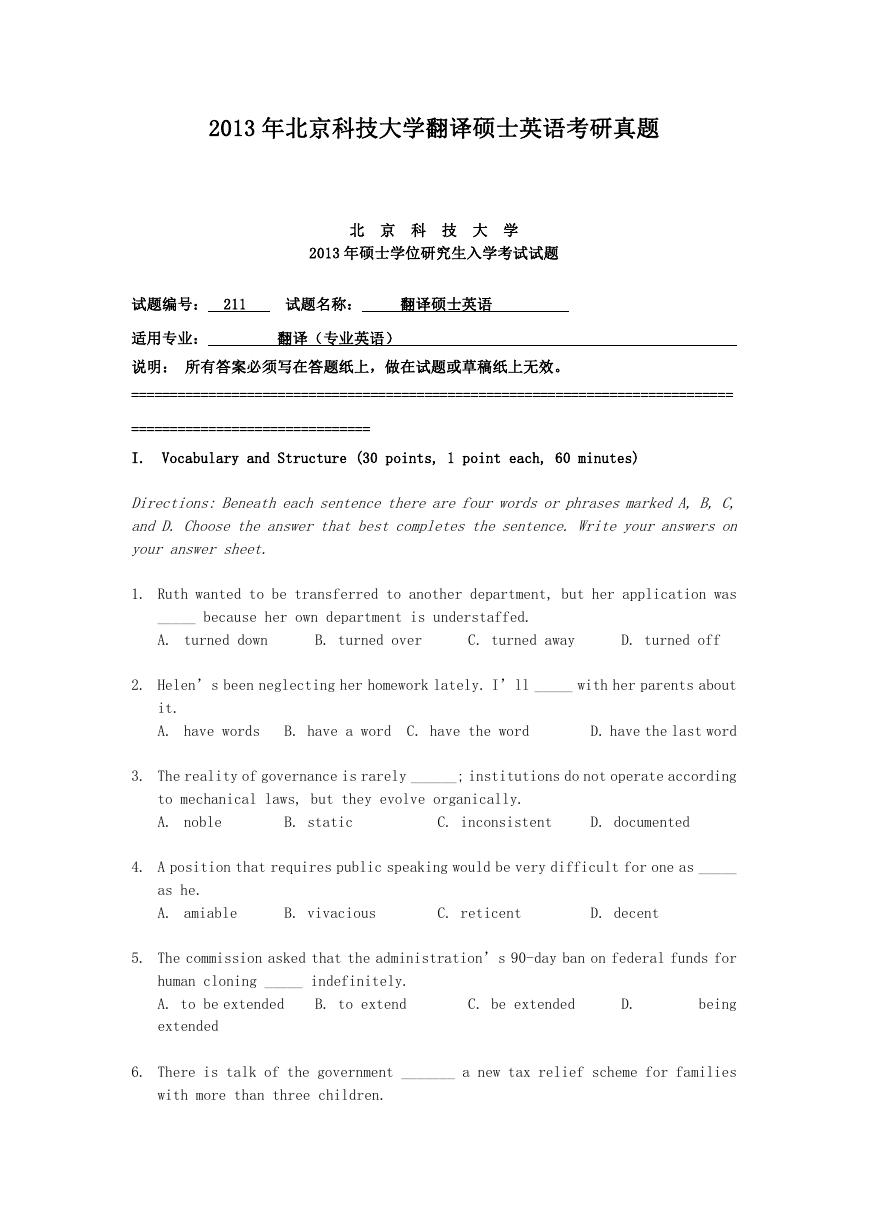
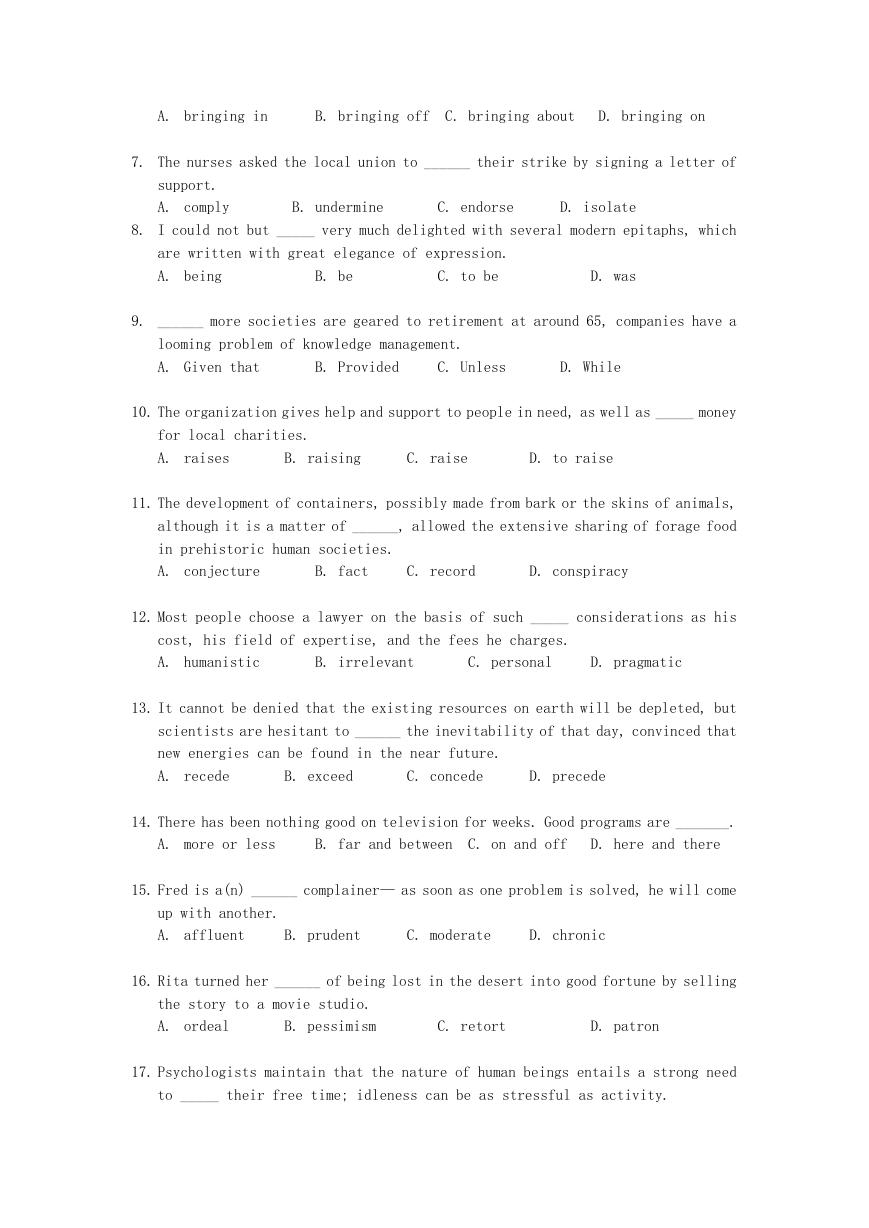
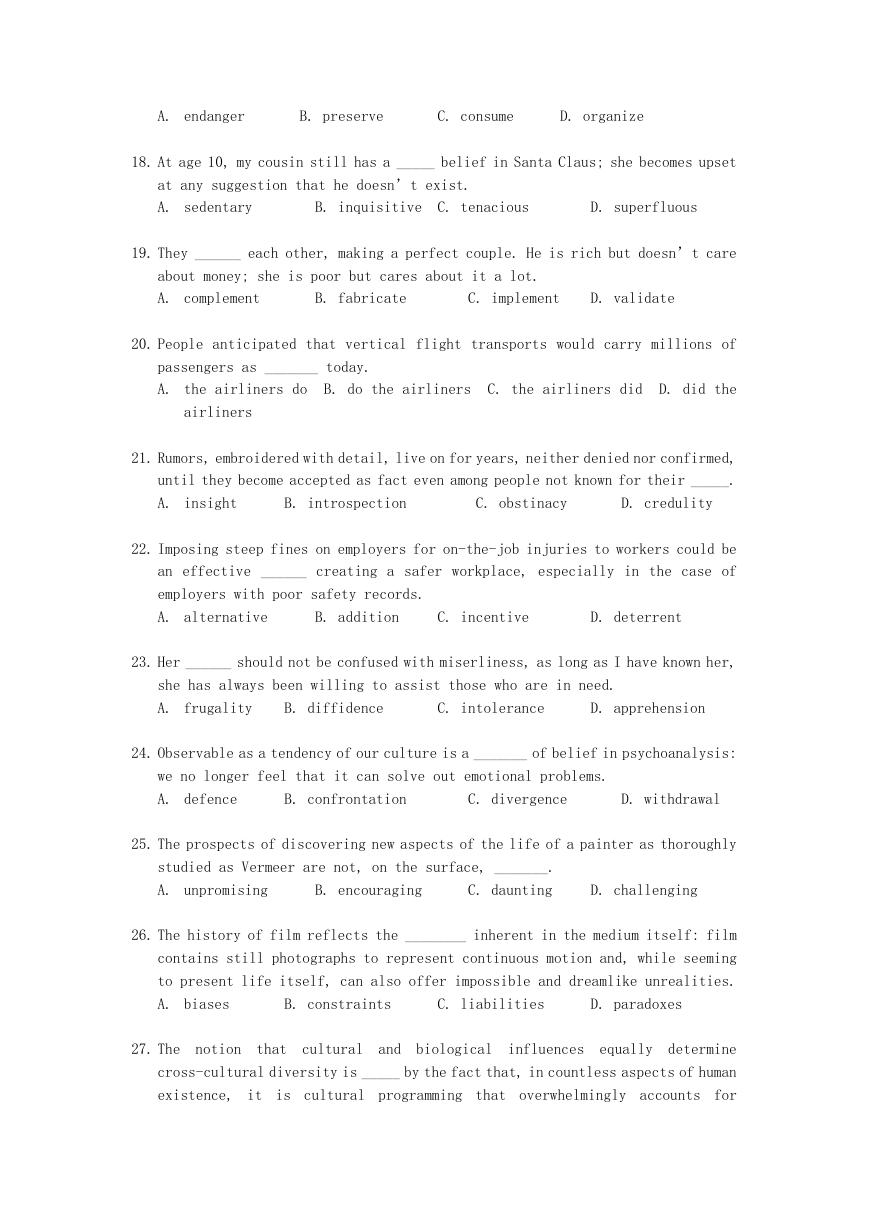
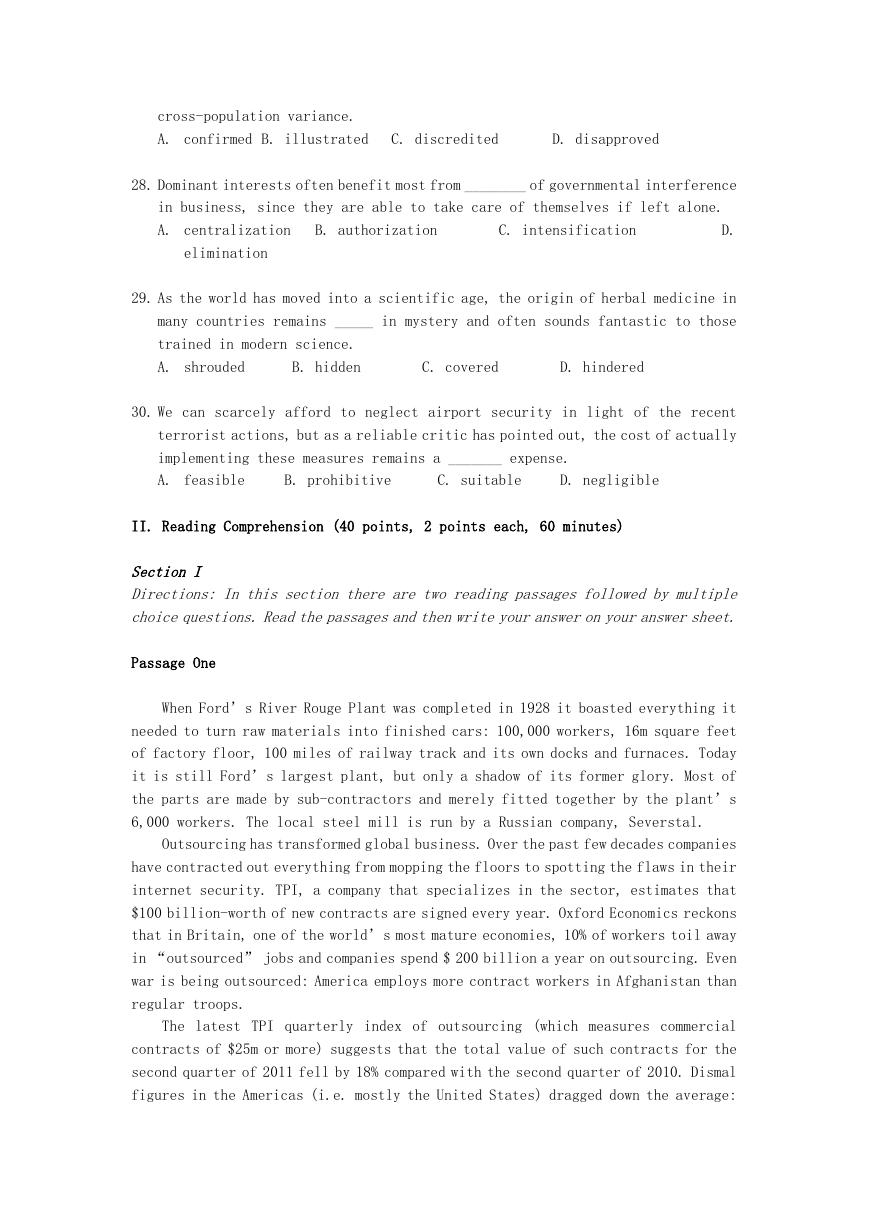


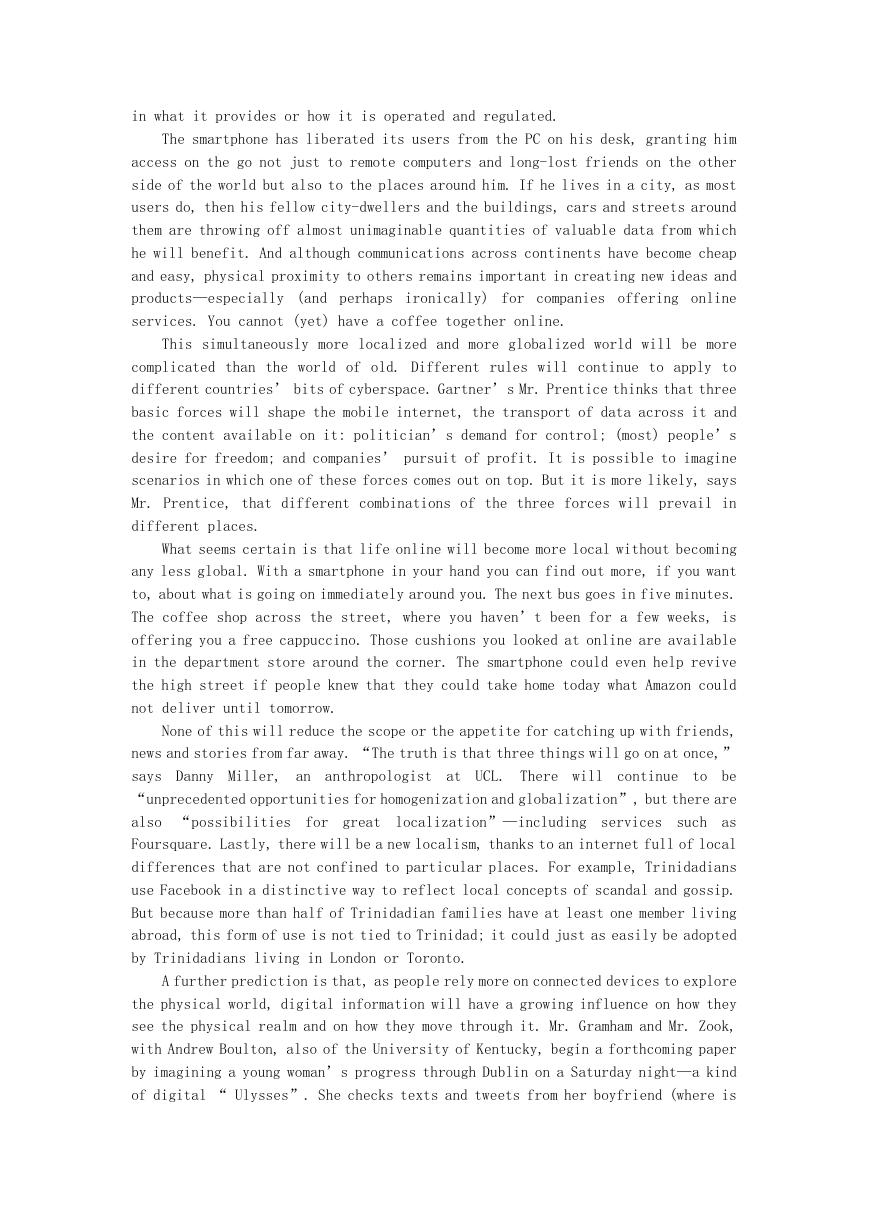
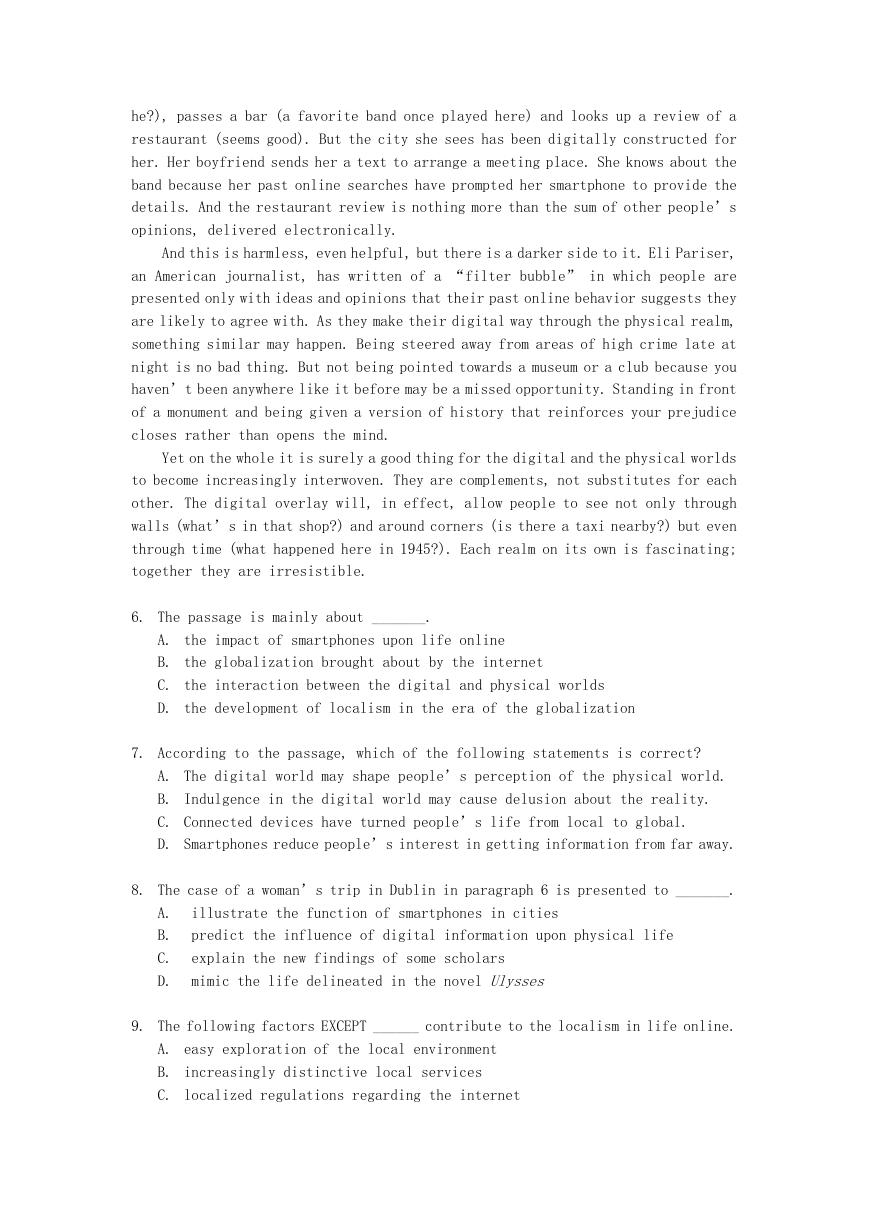








 2023年江西萍乡中考道德与法治真题及答案.doc
2023年江西萍乡中考道德与法治真题及答案.doc 2012年重庆南川中考生物真题及答案.doc
2012年重庆南川中考生物真题及答案.doc 2013年江西师范大学地理学综合及文艺理论基础考研真题.doc
2013年江西师范大学地理学综合及文艺理论基础考研真题.doc 2020年四川甘孜小升初语文真题及答案I卷.doc
2020年四川甘孜小升初语文真题及答案I卷.doc 2020年注册岩土工程师专业基础考试真题及答案.doc
2020年注册岩土工程师专业基础考试真题及答案.doc 2023-2024学年福建省厦门市九年级上学期数学月考试题及答案.doc
2023-2024学年福建省厦门市九年级上学期数学月考试题及答案.doc 2021-2022学年辽宁省沈阳市大东区九年级上学期语文期末试题及答案.doc
2021-2022学年辽宁省沈阳市大东区九年级上学期语文期末试题及答案.doc 2022-2023学年北京东城区初三第一学期物理期末试卷及答案.doc
2022-2023学年北京东城区初三第一学期物理期末试卷及答案.doc 2018上半年江西教师资格初中地理学科知识与教学能力真题及答案.doc
2018上半年江西教师资格初中地理学科知识与教学能力真题及答案.doc 2012年河北国家公务员申论考试真题及答案-省级.doc
2012年河北国家公务员申论考试真题及答案-省级.doc 2020-2021学年江苏省扬州市江都区邵樊片九年级上学期数学第一次质量检测试题及答案.doc
2020-2021学年江苏省扬州市江都区邵樊片九年级上学期数学第一次质量检测试题及答案.doc 2022下半年黑龙江教师资格证中学综合素质真题及答案.doc
2022下半年黑龙江教师资格证中学综合素质真题及答案.doc